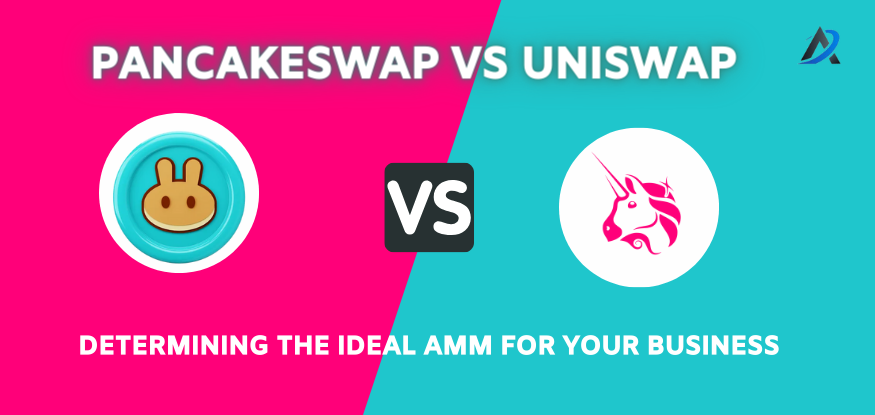Choosing Between PancakeSwap and Uniswap: Determining the Ideal AMM for Your Business

PancakeSwap’s recent surge mirrors Uniswap’s model, offering a strong alternative amid Ethereum’s rising fees and congestion. While Uniswap initially dominated due to its advantage and robust foundation, PancakeSwap’s sudden ascent, fueled by the Binance Smart Chain community, ignited a substantial surge in adoption and trading volume. Comparing these platforms unveils nuances in their AMM approaches, highlighting their journey to becoming top decentralized exchanges (DEXs). Exploring their differences provides crucial insights for users navigating these ecosystems. PancakeSwap’s emergence signifies a notable shift in the DeFi landscape, urging users to discern each platform’s strengths and weaknesses for tailored trading solutions in this evolving market.
Understand PancakeSwap
PancakeSwap, established as a leading automated market maker (AMM) and yield farming platform in the Binance Smart Chain ecosystem, swiftly gained momentum since its inception in previous years. Allowing users to stake the native CAKE token or provide liquidity to lending pools, it offers rewarding CAKE incentives. These rewards, harvestable and reinvestable, provide a simple way to generate passive income in DeFi. Beyond its foundation resembling Uniswap, PancakeSwap introduces various modifications and additional features like staking, NFTs, team collaborations, and a lottery system, diversifying its offerings. It’s notable growth positions PancakeSwap as a formidable contender to Uniswap’s AMM dominance, solidifying its place in the decentralized finance landscape with potential for further expansion and influence.
Understanding Uniswap
Uniswap reigns supreme among decentralized exchanges (DEXs) and automated market makers (AMMs) on the Ethereum network, boasting a substantial total value locked (TVL) exceeding $4.37 billion. Renowned for its AMM functionality, Uniswap facilitates seamless ERC-20 token swaps without conventional order books, ensuring decentralized and swift transactions. Operating without the need for buyers or sellers on the opposite end, it upholds privacy by omitting KYC protocols, fostering wider participation. Uniswap’s consistent high rankings on DeFi Pulse underline its pivotal role in shaping decentralized trading platforms amidst intensifying competition. Automated Market Makers (AMMs) have notably revolutionized the crypto landscape, diverging from centralized exchange models by utilizing algorithmic smart contracts for order execution. Uniswap’s unique AMM model continues to serve as a cornerstone in the DeFi sector.
Difference Between PancakeSwap and Uniswap: Exploring The Rivalry
PancakeSwap and Uniswap diverge significantly in their underlying blockchains. While Uniswap relies on Ethereum, PancakeSwap operates within the Binance Smart Chain (BNB). This distinction results in stark differences in transaction fees and speeds, with PancakeSwap, leveraging the BNB chain, showcasing notably lower fees and quicker transaction times compared to Uniswap’s Ethereum network.
Beyond their blockchain variances, PancakeSwap stands out by offering an array of services beyond trading. Its repertoire includes a yield farming protocol, Syrup Pools, IFO, Lotteries, among others, presenting a more diversified platform compared to Uniswap, which primarily focuses on trading and swapping functionalities.
When considering the tokens and trading pairs available, PancakeSwap boasts a higher count with around 2503 listed tokens and 3937 trading pairs in June 2023, according to Coingecko Data. In contrast, Uniswap hosts approximately 937 listed tokens and 1875 trading pairs, showcasing a difference in variety and options for users.
Moreover, both DEXs support browser wallet extensions, yet using MetaMask— a widely used wallet—with PancakeSwap requires the addition of the Binance Smart Chain network, while Uniswap seamlessly integrates with MetaMask straight out of the box, simplifying accessibility for users.
Contrasting Uniswap With PancakeSwap
Uniswap operates on Ethereum, while PancakeSwap is built on the Binance Smart Chain (BSC), defining their distinct blockchain foundations. This disparity shapes the tokens available for trading and influences associated transaction fees.
Listed tokens
Uniswap boasts a broader array of tokens available for trading, including ERC-721s (non-fungible tokens), expanding its versatility. In contrast, PancakeSwap solely supports tokens native to the Binance Smart Chain (BSC), limiting its trading scope.
Adoption Rate
Comparing established Decentralized Exchanges (DEXs) regarding their success and adoption proves challenging. Uniswap’s ascent post-introduction of Automated Market Maker (AMM) functionality revolutionized DeFi, yet PancakeSwap’s rapid growth via BSC and the CAKE token sparks speculation about potential overtaking. Despite Uniswap’s larger user base, PancakeSwap’s soaring trading volume suggests a shift in authority, showcasing different value propositions that appeal to diverse user bases. Watching PancakeSwap’s trajectory toward Uniswap’s level of popularity remains intriguing.
Transaction Fees
Uniswap implements a fixed 0.3% transaction fee, notably lower than most centralized exchanges. Conversely, PancakeSwap features variable fees based on liquidity pool availability, generally maintaining substantially lower trading fees compared to Uniswap.
Native tokens
1. CAKE token
PancakeSwap utilizes its native token to incentivize and reward users engaging in liquidity provision on the platform. The release of PancakeSwap’s V2 update in May 2022 introduces several advantages for CAKE token holders, including capped total supply at 750 million. This update unlocks new benefits such as weighted voting, amplified farm yields, and improved IFO allocations. Despite maintaining the burning mechanism for CAKE, users continue to benefit from its original utilities—rewards for liquidity provision, lottery incentives, and its roles as governance and utility tokens for lottery tickets and IFO token sales. For those interested, CAKE tokens are available for purchase on major exchanges like Binance, Kucoin, and SushiSwap.
2. UNI token
Uniswap employs its native token to incentivize and reward users contributing liquidity to the platform, enabling voting rights for proposed protocol alterations. The token, distributed via airdrop in September of previous years to previous Uniswap traders, saw 1 billion UNI tokens minted at Genesis. Allocation was divided among the Community, Team, Investors, and Advisors at portions of 60%, 21.51%, 17.80%, and 0.69% respectively. Token holders now participate in Uniswap’s governance, influencing fund allocation and suggesting platform modifications through their UNI token ownership. Those interested can acquire UNI tokens through prominent exchanges like Coinbase, Binance, and Bitfinex.
When Comparing PancakeSwap and Uniswap, Which One Stands Out as The Superior Choice?
After delving into the similarities, disparities, and advantages of both DEXs, the quest for the better option emerges. The verdict, though, isn’t straightforward—it’s contingent on various factors. The presence of a specific token or pair, your objectives, and strategic inclinations—whether it’s about fee reduction, yield optimization, or other aims—dictates the better choice. Additionally, your preference for decentralization weighs in; the Ethereum blockchain typically offers a higher decentralization quotient compared to the more centralized Binance Smart Chain.
However, an essential aspect to ponder is the impending transition to ETH2, which promises improved transaction speeds and reduced fees. Until this transformation unfolds, contemplating PancakeSwap for smaller transactions during peak Ethereum network usage and considering Uniswap for accessing a wider array of tokens or executing larger transactions might be prudent. Each platform carries its distinct advantages, and the choice ultimately hinges on aligning these features with your specific trading needs and preferences.
Concluding Thought
PancakeSwap and Uniswap have expanded their horizons, penetrating each other’s domains. Initially, in the DeFi realm, Uniswap dominated Ethereum transactions, while PancakeSwap served traders on the BNB Chain, offering unique token selections. However, the landscape has evolved significantly. Uniswap now navigates the BNB Chain, while PancakeSwap asserts its presence on Ethereum. This shift blurs the lines between once-distinct exchanges, transforming them into direct rivals competing for user engagement.
Moreover, entrepreneurs seeking to venture into PancakeSwap or Uniswap development find an essential link through DeFi exchange clone script providers. These providers facilitate the creation of platforms akin to PancakeSwap or Uniswap, offering entrepreneurs a gateway to tap into the decentralized exchange market swiftly and efficiently. Whether aspiring to replicate PancakeSwap’s offerings or leverage Uniswap’s features, contacting a DeFi exchange clone script provider becomes integral for those venturing into the DeFi space.
